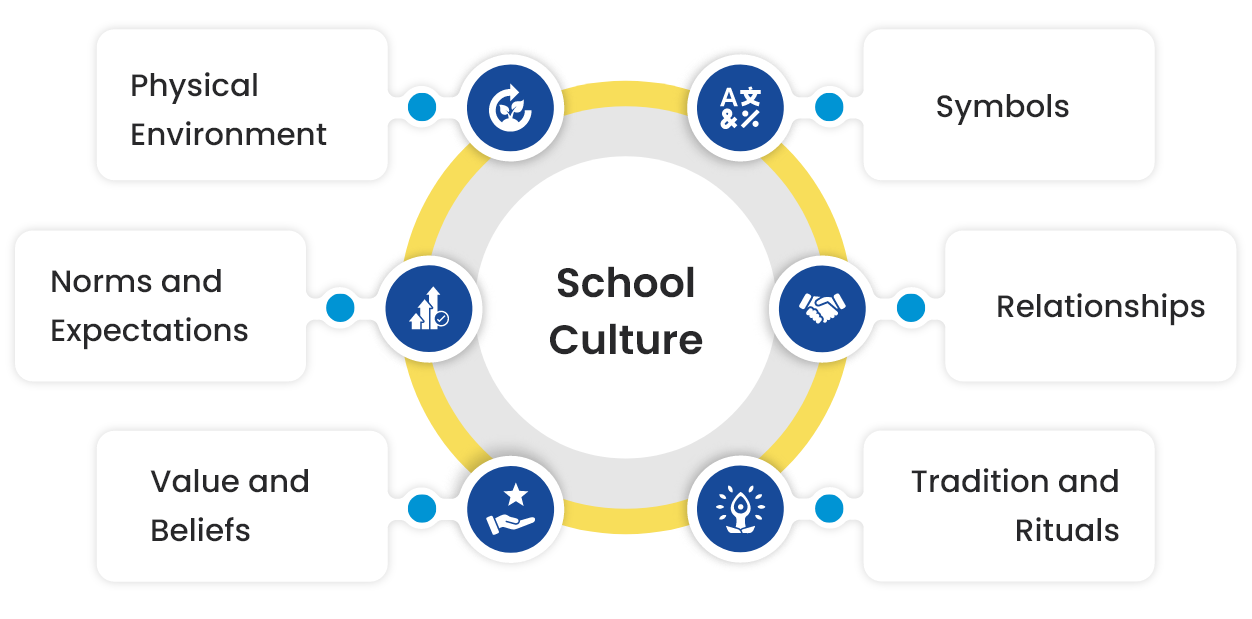

Culture is of great importance in schools run under the Bhartiya Shiksha Board. We aim to connect students with moral values, traditions, rich cultural heritage, and education. School culture promotes academic excellence and creates a positive and inclusive environment.
A school is not only a place to acquire education but also a centre for developing children's personality, ethics, and social responsibility. A positive school culture helps in the overall development of children and teachers.
A strong foundation of shared beliefs, traditions, values and trust is essential for improving performance in any organization, especially schools. These elements infuse passion, purpose and spiritual energy into an institution. If the culture of a school is not strong and positive, it may become unstable and face failure. School culture plays a vital role in achieving excellence
The concepts of the physical environment of the school and school culture run parallel, yet they are two different components. The physical environment of the school defines the quality and character of school life. It reflects the attitude or spirit of the school. On the other hand, school culture is like the personality of the school.
Some of its important aspects are: adequate classrooms in the school, suitable paint and varnish, medicinal and attractive flowers and plants in the campus, suitable furniture, a useful playground etc.
Symbols are small, verbal, written, physical or physical signs that remind us of the characteristics of a work, number or person. The scope of symbols is wide. They express emotions in the form of sounds, colours, pictures, physical gestures, clothes, crafts or in many other forms. Human society has been using them for centuries. Symbolic pictures of parents and children made by our ancestors have been found on the stones of ancient caves. Along with talking about the ideological and social aspects of school symbols, it is also important for us to understand their practical aspects and means. Examples of some symbols are:
Relationships in school are based on respect, cooperation and dialogue. These relationships not only promote academic progress but also create a positive, inclusive and inspiring community.
Relationship skills are developed in a more organised and defined manner at school than at home. It teaches children to understand the breadth of relationships and to organise them. The school provides children with benchmarks of academic values to build relationships so that they can differentiate between right and wrong. Relationships operate at several levels in the school organisation:
Traditions are significant singular events that have a special history and meaning and occur year out. These traditions grow and keep the good and helpful values for society. Tradition isn’t just something old from the past—it’s a collection of the best qualities and habits that older people give to younger ones. Traditions and are part of the history of the school and tie people to its cultural roots. There are many traditions and rituals in schools. Here are some examples:
Values are the core of what the school consider important. Values are the standards set for what is “good”, what quality means, and what defines excellence-what is valued. Value shapes behaviour, decision making and attention because people attend to what they consider important.
Beliefs are understandings about the world around us. They are consciously held, cognitive views about truth and reality. In schools, staff, students, parents and Principals hold beliefs about all the major aspects of the organisation- beliefs about teacher responsibility for student learning, student capacity, ethnicity and social class, change and innovation, and particularly about the nature of students and their motivation.
Norms are predetermined expectations that are set to determine a particular social or personal situation or behaviour. These arise from social or personal experiences and are established concerning the future. Their main purpose is to mould our personality, behaviour and mutual relations into a purposeful discipline. They extend to various fields. Though they are abstract, they sometimes take concrete forms in the form of written rules, formulas and behaviour. A few examples of norms are punctuality, cleanliness, discipline and self-reliance.